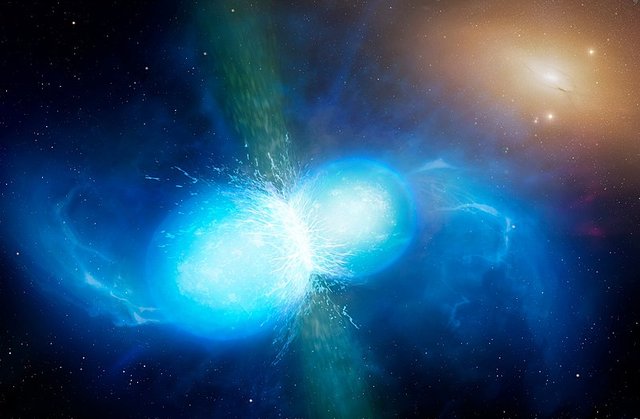Neutron Star : The Densest Object in the Universe

The Neutron Star is the star that attracts the most attention of scientists because this star has its own uniqueness. Neutron star is a dwarf star with an average diameter of about 13 - 25 km, but this star has a mass of about 1.4 solar masses, this is because neutron stars have a very large density compared to all types of stars that have been studied in the universe.
Due to this density, A Neutron star has a very large gravitational field, its gravitational field capable of crushing objects on its surface and the atoms of the object. As an illustration, if you fall into the surface of a neutron star, you will hit its surface at a rate of 150,000 km per second, equivalent to 100 megatons of a nuclear explosion caused by the collision.
Neutron stars can also have magnetic fields up to 100 gigatesla. Such a magnetic field can destroy all the information inside all the credit cards that are on the surface of the Earth if the neutron star is placed in the orbit of the Moon. For comparison, the Earth's magnetic field is only about 60 microtesla in magnitude.
Neutron stars form from giant stars that end their lives with supernova explosions. As the giant stars ran out of fuel, the force of gravity began to work and there was a series of fusion reactions and nuclear fission that resulted in a very powerful supernova explosion that emitted bright light beating all the light in the galaxy where the star lives.
In order for a large star to be a neutron star, its mass must be 8 times larger than the sun's mass, but not more than 20 to 30 times the mass of the sun. Heavier stars will become black holes, while lighter stars will end up as white dwarfs if they experience a similar process. In addition, the law of conservation of momentum will raise the star's rotation drastically, an explanation of why neutron stars can rotate to 600 revolutions per second.
The surface of a neutron star consists mostly of iron atom nuclei in very dense conditions, The star has a temperature of about 1 million Kelvin, The atmospheric neutron star has a thickness of 1 meter and is dominated by an intense magnetic field of 1,012 Gauss.
When digging deeper into the neutron star, the density will be higher as the nucleus is composed of neutrons. The nucleus of a neutron star is thought to consist fluid superconducting a proton and electron!
The first neutron star Discovered by Walter Baade and Fritz Zwicky in 1933 for their hypothetical explanations for explaining supernova triggers. In 1965, Antony Hewish and Samuel Okoye discovered an object that emits radio wave radiation in the Crab Nebula located in the Orion constellation. After intensive research, the discovery was confirmed as a neutron star called a pulsar or a rotating neutron star.
Reference :
https://en.wikipedia.org/wiki/Neutron_star
https://www.space.com/22180-neutron-stars.html
https://www.astro.umd.edu/~miller/nstar.html
https://imagine.gsfc.nasa.gov/science/objects/neutron_stars1.html
https://www.quantamagazine.org/squishy-or-solid-a-neutron-stars-insides-open-to-debate-20171030/
https://www.newscientist.com/article/dn13566-mountains-on-stars-could-trigger-gravitational-waves/
You got a 1.66% upvote from @postpromoter courtesy of @alf4t1h!
Want to promote your posts too? Check out the Steem Bot Tracker website for more info. If you would like to support the development of @postpromoter and the bot tracker please vote for @yabapmatt for witness!